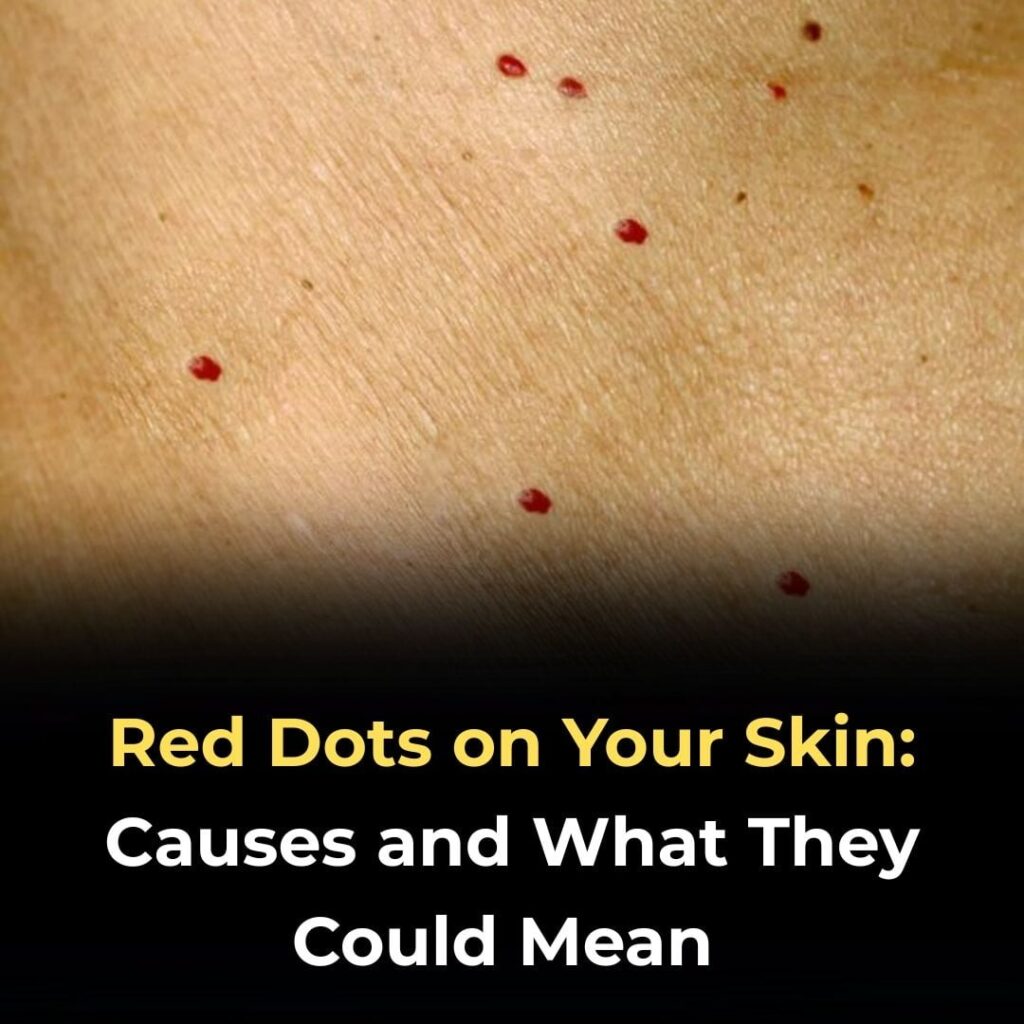
You’re getting dressed, showering, or just glancing in the mirror — and you notice them:
Tiny red dots scattered on your arms, legs, torso, or face.
They don’t itch.
They don’t hurt.
But they weren’t there before.
Should you panic?
Probably not.
Red dots on the skin are incredibly common — and in most cases, completely harmless. They can be caused by aging, sun exposure, minor irritation, or even genetics.
Let’s explore 11 real reasons why these spots appear — so you can understand what’s likely going on… and when it’s time to see a dermatologist.
Because real peace isn’t about diagnosing yourself online.
It’s about knowing what’s normal — and recognizing what’s not.
What Are Red Dots on the Skin?
“Red dots” is a general term for small red spots that can vary in size, shape, and cause. Most are not dangerous and fall into one of several categories:
✅
Cherry Angiomas
Bright red, round or oval bumps — very common with age
✅
Petechiae
Tiny flat red/purple spots from broken capillaries
✅
Keratosis Pilaris
Small rough bumps, often on upper arms
✅
Heat Rash (Miliaria)
Clusters of tiny red dots from blocked sweat glands
✅
Allergic Reactions / Hives
Raised, itchy red spots that come and go
Most develop gradually and require no treatment.
✅ 11 Common Causes of Red Dots (And What They Mean)
1. Cherry Angiomas (Campbell de Morgan Spots)
Caused by clusters of dilated blood vessels
Very common after age 30
Harmless — but can be removed for cosmetic reasons
When to see a doctor: If they bleed easily or change rapidly.
2. Petechiae (Tiny Broken Capillaries)
Flat, pinpoint red or purple dots (don’t blanch when pressed)
Caused by strain (coughing, vomiting), injury, or low platelets
Can appear after aggressive rubbing or tight clothing
⚠️ See a doctor if: Widespread, accompanied by fever, bruising, or fatigue — could indicate infection or blood disorder.
3. Sun Damage (Solar Lentigines & Telangiectasia)
Reddish-brown spots or visible capillaries from UV exposure
Often on face, chest, shoulders, arms
More common in fair-skinned individuals
✅ Prevention: Daily sunscreen, protective clothing
4. Keratosis Pilaris (“Chicken Skin”)
Rough, bumpy texture with tiny red or flesh-colored dots
Usually on upper arms, thighs, cheeks
Caused by keratin buildup in hair follicles
Treat with moisturizers containing lactic acid or urea.
5. Heat Rash (Miliaria)
Clusters of small red dots in sweaty areas (neck, chest, under breasts)
Happens when sweat ducts get blocked
Common in hot, humid weather or overdressing babies
Cool down, wear breathable fabrics, stay dry.
6. Allergic Reaction or Contact Dermatitis
Red dots or patches triggered by:
Soaps, detergents, fragrances
Plants (poison ivy, sumac)
Metals (nickel in jewelry)
✅ Usually itchy; resolves once allergen is removed.
7. Insect Bites (Mosquitoes, Fleas, Bed Bugs)
Raised red dots, often in lines or clusters
May swell, itch, or blister
Appear at night or after outdoor activity
Wash area, use anti-itch cream, inspect bedding if bites persist.
8. Hives (Urticaria)
Raised, red, itchy welts that come and go within hours
Triggered by allergies, stress, infections, or medications
Can be acute (short-term) or chronic (weeks/months)
Antihistamines help; see a doctor if breathing is affected.
9. Folliculitis
Inflamed hair follicles look like red pimples around hairs
Caused by friction, shaving, sweat, or bacteria/fungi
Common on legs, buttocks, beard area
Keep skin clean and dry; avoid tight clothing.
10. Spider Veins (Telangiectasia)
Fine red or blue lines near the surface of the skin
Often on face or legs
Linked to sun damage, hormones, or prolonged standing
Cosmetic concern — treatable with laser therapy if desired.
11. Normal Aging (Senile Purpura)
Flat red-purple blotches on hands, forearms
Thin skin + fragile blood vessels = easy bruising
Harmless but more noticeable with age
️ Protect skin with SPF and moisturizer.
❌ Debunking the Myths
❌ “Red dots mean liver failure”
False — no direct link unless other symptoms present
❌ “They’re always a sign of cancer”
Dangerous myth — skin cancers have specific features (see below)
❌ “Only unclean people get them”
No — anyone can develop red dots regardless of hygiene
❌ “Scratching causes all red spots”
Not true — many appear without any irritation
When to See a Dermatologist
Don’t panic — but do act if you notice:
A spot that changes shape, color, or size
Bleeding, crusting, or non-healing sores
Rapid spread of dots with fever or illness
Pain, warmth, or swelling (possible infection)
Suspicious moles (use the ABCDE rule: Asymmetry, Border, Color, Diameter, Evolving)
A dermatologist can diagnose with a visual exam or biopsy if needed.
Final Thoughts
You don’t need to worry every time you find a new dot on your skin.
Most red spots are normal, harmless, and part of life — whether from aging, sun, or simple irritation.
So next time you’re scanning your arms…
take a breath.
Look closely.
Stay calm.
Ask questions.
And if something feels off?
Talk to a professional.
Because real health isn’t about perfection.
It’s about listening — gently, wisely, and without fear.Buy vitamins and supplements
And that kind of care?
It starts with one quiet moment in front of the mirror.